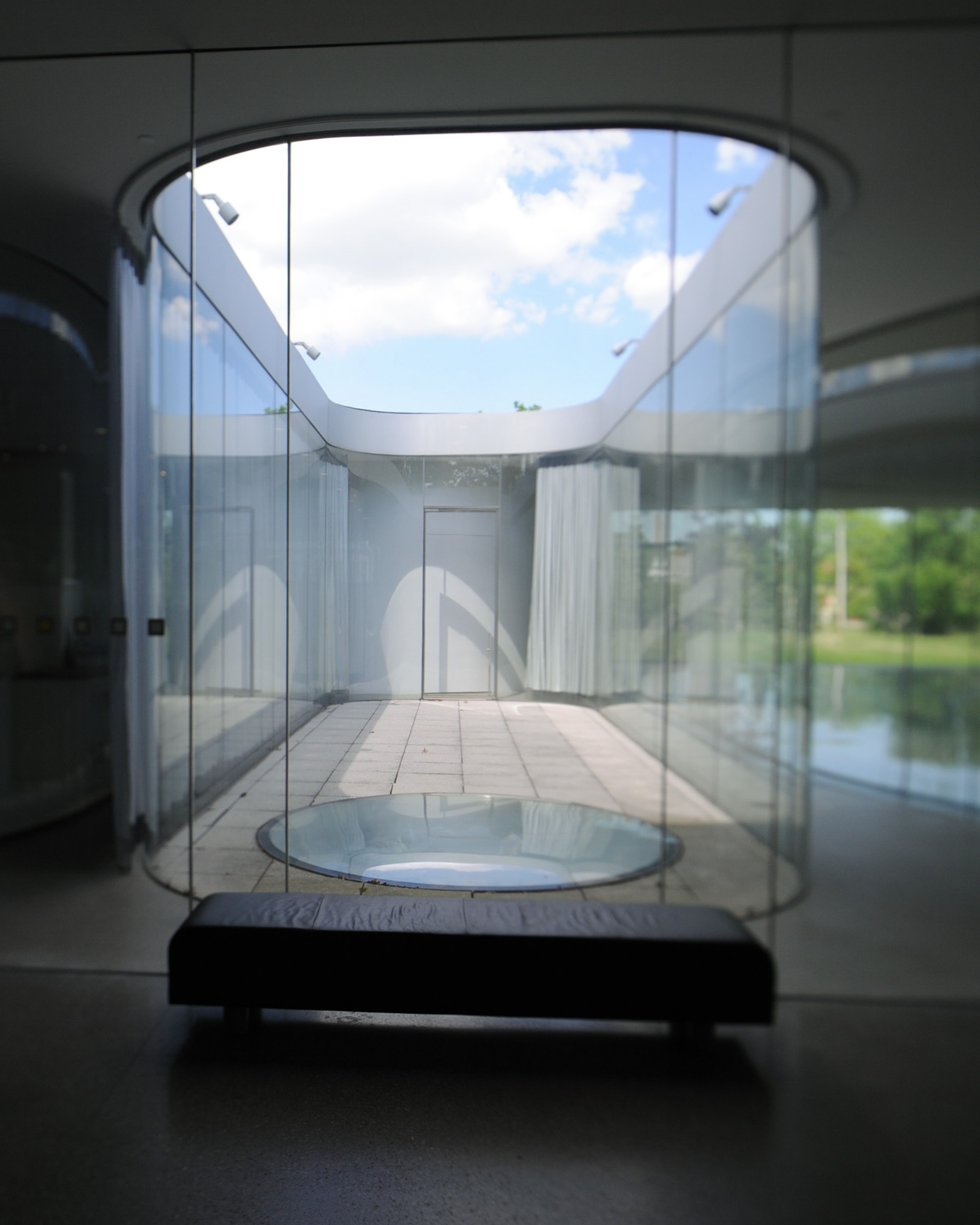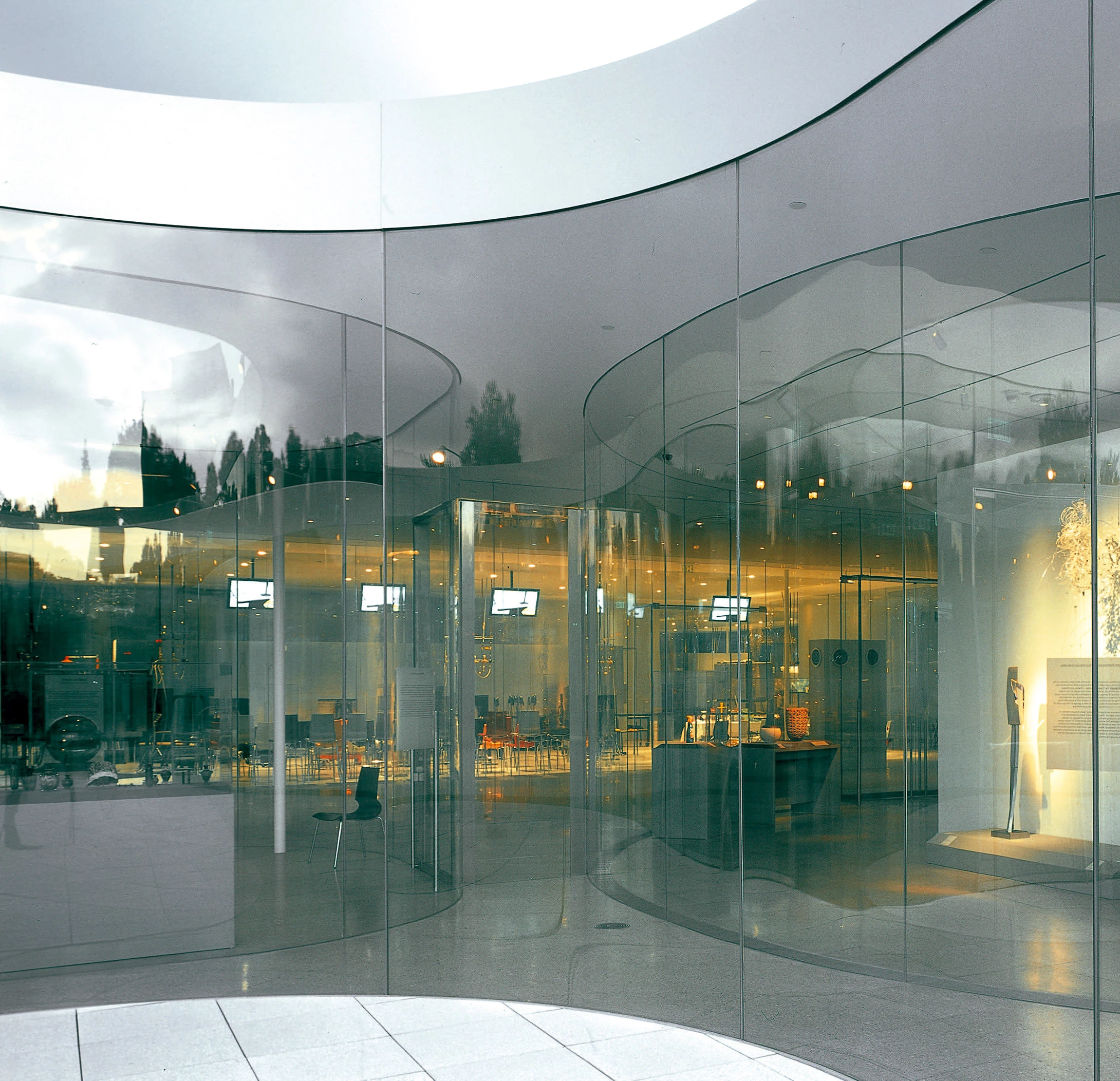Basic Info
The Glass Pavilion is an art gallery located on the Toledo Museum of Art's campus in Toledo, Ohio1. With walls made almost entirely out of glass, this shining gemstone was designed by Kazuyo Sejima and Ryue Nishizawa. It began design in 2001, with construction lasting from 2004 to 20062. It cost around 20 Million USD and uses 225 tons of steel and 3950 cubic meters of concrete3.
The building is primarily Used as an Exhibit for glass art at the Toledo Museum (Figure 1). It also frequently hosts glass-blowing workshops for the public4. Given the existence of a multipurpose room, there could potentially be conferences, auctions, field trips, weddings, and more in the building.

The Scholars
Studies conducted on the Glass Pavilion show the lengths that were made to achieve the nearly completely glass walls of the building. In a study by Brett Schneider and Guy Nordenson, they outline four details of construction that are unusual about the building3. These details include continuous support structures (girders and joists) and the unusual construction of the roof. It is noted that these details make installing plumbing and electrical lines a challenge, but is necessary to achieve the mostly glass walls.
Another article written by the Arquitectura Viva, an architecture publisher, in an architecture magazine, focuses on the glassier aspects of the Glass Pavilion4. It highlights the fact that the building comes as a reference to the prominence of the glass production industry in Toledo during the early 20th century. Not just featuring glass art, but being art itself, the glass walls sometimes have a greenish hue for visitors to enjoy the landscape through. The article also mentions that the building contains complex climate control systems that prevent the glass walls from fogging up.
The societal context of the Glass Pavilion is covered by Carolyn Erler6. She imagines the building as made up of the many artists who have their works housed in the building. Outlining the narratives of workers and people, both poor and rich, the article views the Glass Pavilion through what it coins "the spirit of social transparency" (Erler 172).
Eyes Light the Way
For your personal enjoyment (and mine), I have put some images relating to the Glass Pavilion below.

Glass Pavilion Technical Diagrams for Columns and Roof Girding: 
For some pictures of the exterior, we have the following two figures. The first figure is labeled with the materials used for major parts of the building.
 Thin Veil: Small, unnoticeable steel poles, distributed throughout the building, carry most of the weight and support the glass walls4
Thin Veil: Small, unnoticeable steel poles, distributed throughout the building, carry most of the weight and support the glass walls4
 See Through World: The glass seems to give a half glimpse of what's inside and a half reflection4
See Through World: The glass seems to give a half glimpse of what's inside and a half reflection4
I also included pictures from the interior, which gives us a clearer view at what is inside.
 Transparent Room: There is an outdoor section in the middle of the building which is visible from many parts of the building8
Transparent Room: There is an outdoor section in the middle of the building which is visible from many parts of the building8
 Glass Blowing Class: The building has a burning hot furnace for glassblowing workshops8
Glass Blowing Class: The building has a burning hot furnace for glassblowing workshops8
 The Bowl: There are occasionally spots with solid walls which create interesting light and dark areas within the building9
The Bowl: There are occasionally spots with solid walls which create interesting light and dark areas within the building9
From a Flickr album by the user thegoatisbad10 five images stuck out to me as highlighting what makes the Glass Pavilion so incredible. The first image shows how transparent the building is, as we can see hallways, rooms, and the outside from well within the building (Figure 4). A closeup shot of the wall gives us certainty that not only do the walls not fog up, but they also inexplicably remain clean (Figure 5), probably due to good maintenance or material.


Parts of the wall also seem to take on different hues. White hues are noticed on the inner walls surrounding an open inner area (Figure 6). Green hues can be seen on the outer walls (Figure 7). These different hues could effect a visitor's experience as they walk through the Glass Pavilion. They would literally be watching the outside world through different lenses.


Whether from the outside or inside, very few places in the Glass Pavilion are truly hidden. This could be a statement on social transparency, which was alluded to by a study on the building we discussed earlier in this post (Figure 8).

I also made a sketch of the museum (Figure 9). I tried to highlight the idea that every part of the building is viewable from any other part. There are outlines of walls in my sketch that hint at a physical barrier, yet everything in the building is laid bare. Even viewing from the outside, one can see the glassblowing room on the left and a gallery on the right. I tried to make the sketch as accurate as possible, but it was hard to sketch everything without it too getting cluttered to make sense of.

Google Earth
Traveling through the street on Google Earth, we can observe that the museum is in a diverse neighborhood. One street seems to be a suburban neighborhood, which appears simple, but is filled with houses reminiscent of the Victorian era. On another street, there appears to be a metro and a theatre. The theatre stretches across the length of an entire block and features great pillars around the building. Due to the large concentration of trees, it is also hard to make out the Glass Pavilion from many angles. The Glass Pavilion seems almost unnoticeable due to its small height and the many trees in the area. The buildings around the Glass Pavilion contrast with it in style. The Glass Pavilion appears more modern due to its extensive use of glass and flowing walls. The buildings around it seem to share the theme of being from an older era. In a sense, the Glass Pavilion is surrounded by great historical architecture, separated from them physically and artistically.
Talking with Users
In an interview with Darren Goodman, we get to know that he teaches glassblowing at the Glass Pavilion11. He particularly notes how the environment of the building, along with the glass walls enhanced the experience of glassblowing. He says that seeing through the whole building and watching the snow outside while glassblowing was an amazing experience.
Documentary
In a documentary about the Glass Pavilion, it is noted that many of the building's functions were moved underground12. Office spaces are underground, and so are electrical lines and plumbing lines. The documentary also goes over the historical background behind the building and its pieces. Toledo's main economy used to be based in glass, with some of the biggest glass making companies based in the city. The glass works that came out of such a time are preserved in the museum.
People who Visited
Marice Brian wrote a blog about the Glass Pavilion13. In their blog, they outline the many things one can find at the museum, including glass from ancient Rome, glass fashion, and glassblowing workshops. They claim that the museum is important in not just being a piece of art, but also holding monumental glass art. I would agree, the architecture serves the purpose of fitting with the theme of the museum. Though the Glass Pavilion itself is something to admire, so are the contents of the building.
About the Architects
The architects for the Glass Pavilion, Kazuyo Sejima and Ryue Nishizawa, were featured on ArchDaily14. The post reveals three interesting facts about the founders of SANAA, the architecture firm that worked on the Glass Pavilion. First, they seem to like designing open, public spaces, which explains the majority of their projects being public spaces. Second, they like to play with light in their designs. Third, they like using white materials and glass to diffuse and spread light. This use of light comes through especially in their design of the Glass Pavilion, which is almost entirely transparent.
References
“Campus & Architecture.” Toledo Museum of Art, n.d. https://toledomuseum.org/about/campus-architecture.
Reband, Pat. “Toledo Museum of Art: Glass Pavilion.” Concrete Construction, June 13, 2005. https://www.concreteconstruction.net/business/management/toledo-museum-of-art-glass-pavilion_o.
Schneider, Brett, and Guy Nordenson. 2008. “Glass Pavilion, Toledo Museum of Art, Ohio.” Structural Engineering International 18 (1): 49–52. doi:10.2749/101686608783726713.
“Glass Pavilion, Toledo Museum of Art, Ohio - SANAA.” Arquitectura Viva, October 27, 2020. https://arquitecturaviva.com/works/pabellon-de-vidrio-museo-de-arte-de-toledo-ohio---4.
Brown, Steve. Glass Pavilion - Toledo Museum of Art. Flickr. Flickr, January 3, 2009. https://flic.kr/p/5PyoKu.
Erler, Carolyn. 2013. “Art of Local Radiance: The Teacher’s Guide to the Toledo Museum of Art Glass Pavilion.” Studies in Art Education 54 (2): 171–86. doi:10.1080/00393541.2013.11518891.
Glass Pavilion at the Toledo Museum of Art. Archweb. Archweb, n.d. https://www.archweb.com/en/cad-dwg/glass-pavilion-toledo/.
Basulto, David. “Glass Pavilion at the Toledo Museum of Art / SANAA.” ArchDaily, March 28, 2010. https://www.archdaily.com/54199/glass-pavilion-at-the-toledo-museum-of-art-sanaa-pritzker-prize-2010.
Speck, Larry. “Toledo Museum of Art, Glass Pavilion.” Larry Speck, September 21, 2020. https://larryspeck.com/photography/toledo-museum-of-art-glass-pavilion/.
thegoatisbad. “Sanaa.” Flickr, n.d. https://flic.kr/s/aHsiU4WGG2.
Goodman, Darren. “Darren Goodman - Glass Experience - Toledo, Ohio.” YouTube, September 29, 2011. https://youtu.be/j8Sr9vuxitc?si=voS1D7e-I9Z2EpZQ.
“How the Toledo Museum of Art Glass Pavilion Was Made Possible | Toledo Stories | Full Film.” YouTube, May 3, 2023. https://youtu.be/EgfNELXnXxU?si=yzQySHH3U4aN5TZW.
Brian, Marice. “Toledo’s Hidden Glass Pavilion Secrets.” TouristSecrets, October 21, 2024. https://www.touristsecrets.com/travel-guide/arts-culture/toledos-hidden-glass-pavilion-secrets/.
Zilliacus, Ariana. “Spotlight: Sanaa.” ArchDaily, October 29, 2019. https://www.archdaily.com/798275/spotlight-sanaa.

Aayush I.
Comment
The guidelines of posting are rather simple. Be respectful and engage honestly. I am not against swearing, but avoid using slurs or generally hateful messages. Use your common sense. Comments will not be posted until they are approved by an admin.